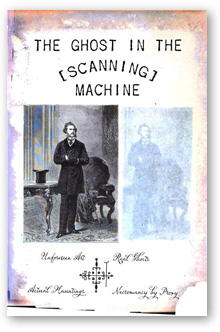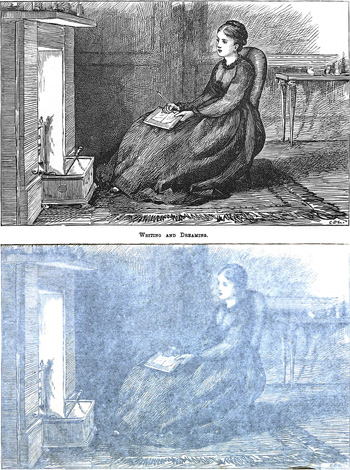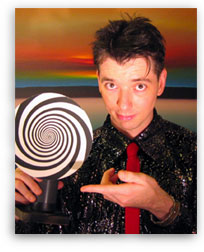|

|
The Ghost in the [Scanning] Machine  This repository of ghostly images was never meant to be. The specters were conjured unwittingly, through a mechanical process of book scanning. Their portraits technically do not exist, except within this context. To explain: in old books, frontispieces were typically protected by a sheet of translucent tissue paper. So thorough is the Google Books scanning process that even this page of tissue paper is scanned. The figure in the plate beneath the tissue — “beyond the veil,” as it were — emerges as from a foggy otherworld. The frontispieces were never meant to be seen this way. Their wraithlike manifestations have been artificially “fixed” in time by the scanning process. In essence, timeless phantasms of dead writers have been captured and bound into a new age.
This repository of ghostly images was never meant to be. The specters were conjured unwittingly, through a mechanical process of book scanning. Their portraits technically do not exist, except within this context. To explain: in old books, frontispieces were typically protected by a sheet of translucent tissue paper. So thorough is the Google Books scanning process that even this page of tissue paper is scanned. The figure in the plate beneath the tissue — “beyond the veil,” as it were — emerges as from a foggy otherworld. The frontispieces were never meant to be seen this way. Their wraithlike manifestations have been artificially “fixed” in time by the scanning process. In essence, timeless phantasms of dead writers have been captured and bound into a new age.And so we call this phenomenon “unforeseen art,” as it constitutes an aesthetic expression without original intent. Just as artists often credit their inspiration to a Muse, the accidental art herein is in the domain of real ghosts; every author here has departed to the Other Side. We call it “necromancy by proxy,” as the scanning machine serves as our “spirit medium” or shaman. |
|||||||||||||||||||||||||||||||||||||||||||||
 |
About the AuthorCraig Conley is a magic enthusiast and scholar. Recognized by Encarta as “America’s most creative and diligent scholar of letters, words and punctuation,” his intensive and eccentric research has led him to compile a true masterwork entitled Magic Words: A Dictionary. He has also authored One-Letter Words: A Dictionary, among other strange and unusual lexicons, and is a regular columnist for Pentacle magazine. Conley’s ideas are often decades ahead of their time. He invented the concept of the “virtual pet” in 1980, fifteen years before the debut of the popular “Tamagotchi” in Japan. His virtual pet, actually a rare flower, still thrives and has reached an incomprehensible size. Featured Works: Published Works |
|||||||||||||||||||||||||||||||||||||||||||||
|
|
Online Resources |
|||||||||||||||||||||||||||||||||||||||||||||
A free daily symbolic outlook
|
||||||||||||||||||||||||||||||||||||||||||||||